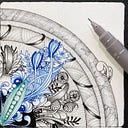Narrating Mountains
A pioneer of Korean abstract and modern art. A canonical artist in Korea’s postwar art history. One of South Korea’s greatest painters. An artist ahead of his time. These are the words art critics have used to describe South Korean artist Yoo Youngkuk in recent years. With how much attention Yoo Youngkuk’s pieces receive nowadays, I was surprised to learn that the artist struggled hard to find buyers just a few decades ago. “Back then society did not understand abstract art and people from his hometown refused to receive his work even as gifts,” said Yu Jin, chairman of the Yoo Youngkuk Art Foundation and son of the artist himself. Yoo can thus be seen as another talented artist who found fame after death.
Yoo was born in 1916 in Uljin, North Gyeongsang Province and educated at the Tokyo Culture Institute in 1935. During his three years in Tokyo, Yoo became active in the Japanese avantgarde movement and experimented with abstract art for the first time. For inspiration, Yoo turned to the natural landscapes he grew up surrounded by. His work became abstract interpretations of mountains, oceans, trees, valleys, and sunsets.
I caught my first glimpses of Yoo Youngkuk’s work through instagram. BTS’s leader Kim Nam-joon had posted photos of himself alongside Yoo’s pieces and I have to admit that at that time he was more the object of my interest than the art. Knowing so little about Yoo, I even attributed the photo’s caption “산은 제 안에 있다” (“The mountain lies within me”) to Nam Joon’s own ingenuity. It was only after I attended the exhibit and saw the same words inscribed on the walls that I realized the line actually belonged to the artist.
It was by the 1960s that Yoo’s trademark aesthetic became the mountain. The centerpiece of most of his paintings, Yoo’s mountains are less so literal representations of mountains, but rather portraits of their spiritual essence. True to the mission of abstract art, Yoo sacrifices realism on the canvas to communicate mood and feeling. Through planes, shapes, lines, and dots, Yoo strives to render how the mountain makes him feel — generally, but also perhaps also about the world around him and himself.
Yoo’s very best pieces balance this expressiveness with aestheticism. With well-balanced composition and the right choice of colors, Yoo is able to channel the serenity, sense of order, and joy he finds in looking at a mountain into a painting that is, while far from representative of external reality, optically delectable. This is why looking at works like “Work, 1966, Oil on Canvas, 130x161.7cm”, “Work, 1964, oil on canvas 162x133cm”, “Work, 1967, oil on canvas, 162x130cm”, and “Work, 1961, oil on canvas, 101.5x81cm” might give you a sensual pleasure that is not too dissimilar from taking a bite out of a fresh piece of fruit or smacking on sweet hard candy (you will understand what I mean if you see the exhibit in person).
While Yoo’s paintings certainly can be enjoyed from a distance or even through a screen, there is something magical about looking at them up close. Studying a piece with your nose just inches away from the canvas (close enough for one of the staff to ask me to “뒤로 물러나 주세요”), you can really discern variances in its surface texture as well as style of brush stroke. For example, I noticed how Yoo gave more surface projection to the peaks of his mountains in a topographical manner. I also took note of how he used counter-directional brush strokes on top of small areas of surface projection to add a sense of intensity and dynamism to where (I presume) he wanted his painting’s focal points to be. Peering into the painting, I could also see how he used the dry brush technique on areas of color transition. This is why when you gaze at the painting from a distance, it has a feeling of naturalism to it — because there are no abrupt changes in color between planes and shapes. Color gradations are slow and fuzzy in Yoo’s paintings, as they often are visually in nature (e.g. sunsets, changing of the leaves).
Through color and simple forms, Yoo intimates the harmony that can be found in nature, but also moments of tension. This friction of sorts is mostly conveyed through a sharp contrast of primary colors — for example, winter blue against vermillion — and juxtaposition of shape. Such abstract depictions of disharmony energize and animate his landscapes.
Since his death in 2002, Yoo Youngkuk has been recognized and celebrated as a principal leader of Korea’s avant-garde art movement. After returning from his studies Tokyo in the 30s, Yoo became an active participant in several notable avant-garde artist groups in Korea like the New Realism Group and the Modern Art Association. Although he lived in an era that did not appreciate his art for its abstractness, thankfully these days Yoo receives all the praise and acclaim he deserves for his creativity and courage.

